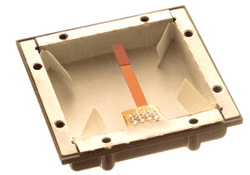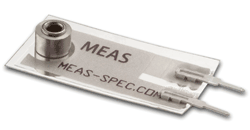Applying piezoelectric film in electronic designs
Piezoelectric film can serve as a highly reliable low-cost alternative to more expensive sensors when space is at a premium
BY JON DENT
Digi-Key
Thief River Falls, MN
http://www.digikey.com
and PETE SMITH
Measurement Specialties
Hampton, VA
http://www.meas-spec.com
Piezoelectric film is a transducer technology with unique capabilities and design advantages. It can produce voltage in proportion to compressive or tensile mechanical stress or strain, making it an ideal dynamic strain gage. Lightweight and flexible, piezoelectric film can serve as a highly reliable low-cost alternative to more expensive sensors, either as an accelerometer or dynamic switch element, in applications where space is at a premium.
The film is characterized as piezoelectric, as it is constructed of multiple, tiny, interlocking crystal domains which have both positive and negative charges. When stress is put onto the crystal elements, symmetry is slightly broken, generating voltage. Even a small bit of piezo film can generate thousands of volts and its signals used to monitor vibration, strain, and pressure.
As a result of its versatility, piezoelectric film can support numerous, diverse applications, as a highly effective, low-cost alternative to traditional piezoelectric sensors in practical applications such as tamper proofing and security system, computer disk drives, home appliance safety monitoring, and automotive in-vehicle security systems, to name but a few.
Tamper-proofing, security
Many of today’s electronic products are designed to routinely transmit, receive and store large amounts of sensitive data. Among these are ATM machines, retail point-of-sale (POS) terminals, personal identification number (PIN) pads on gas pumps, computers used for global internet banking transactions, and critical communications equipment used by military and government.
Due to the high value and sensitivity of the critical daily data captured by these devices, there are regular attempts by unauthorized users to gain forced access to the device to remove, copy, or connect record-and-transmit data to alternate circuits and memory storage devices.
Because of these threats, electronic product manufacturers have developed innovative ways to protect the contents of their electronic modules using piezoelectric film technology. Measurement Specialties’ PVDF piezoelectric film, which is offered by Digi-Key, is used in many of these products.
In this application, a key benefit of piezoelectric film is that it can emit an immediate electrical signal when disturbed, manipulated, damaged, or otherwise tampered. For security or tamper proofing uses, PVDF piezoelectric film is often configured into a multi-layered laminate, wrapped or folded over sensitive electronic circuit boards. In some cases, film is laminated to the interior surface of a module enclosure, much like wallpaper applied to a room. Any attempt to disassemble, drill into, cut open, or otherwise gain access to circuitry is quickly detected.
Piezo film is available in different thicknesses. Thinner films (28 and 52 μm) are most common due to their high capacitance and good mechanical qualities. Thicker film (110 μm) is used where maximum robustness is needed, or if a sensor is intended for use in a thickness-mode application.
Use of piezoelectric film to detect tampering usually involves a combination of two concepts. The first is the drill plate, designed to detect an attempt to cut, tear, melt, or pass a tool through a sensor. The second, known as the breakwire pattern, is designed to protect the drill plate from attempts to remove or peel off the tamper sensor from the enclosure walls.
The drill plate consists of a thin layer (28 μm or about 0.001 in.) of PVDF film, printed on both sides with a soft conductive ink. Normally, there is no conductivity between ink patterns on either side of the film. However, once the film is cut, torn, or melted, or penetrated, the conductive inks short together, and the short can be detected by a monitoring circuit.
A breakwire pattern consists of narrow conductive ink lines printed onto film. The lines are extremely fragile, due to the physical properties of the film surface. The adhesive used to attach the sensor to the enclosure (see Fig. 1 ) is applied to the Breakwire Pattern surface, and if the sensor is peeled from the enclosure, the lines break, the circuit opens, and its state is detected.

Fig. 1. An piezo anti-tamper film is applied to the inside of a module housing.
Signals generated from piezoelectric film can be used to erase critical data in an electronic module so that, by the time an unauthorized user gains access to memory chips, the desired information is already erased. Other designs use signals to disable an entire module, so that it must be returned to the factory for re-activation.
Coaxial cables
Piezoelectric polymers used in piezoelectric film applications are also able to be configured into coaxial cables. Piezoelectric cable is constructed in the same manner as a traditional coaxial cable. There is a center core wire, a surrounding dielectric insulator, and a dielectric conductive shield, with a protective cover over the shield. Piezoelectric cable is fundamentally different in just one way – because dielectric material is made from piezoelectric polymer, when the cable is mechanically stressed, a voltage signal is generated, with amplitude proportional to the level of stress applied. Measurement Specialties’ piezo cable, also available from Digi-Key, is designed for maximum signal sensitivity in the radial direction, so maximum signals are generated when a cable is squeezed or compressed across its thickness.

Fig. 2. A piezo cable in which the sensitive element (the portion sheathed in braided copper) is designed to react to lateral compression.
One major application area for piezoelectric film technology in coaxial cable format is security. Medium- and high security facilities, such as government buildings, military installations, airports, prisons, and power plants, typically also require some degree of electronic external perimeter security. Often, these types of facilities are surrounded by multiple fences, designed to carefully monitor personal access to protected areas. Within this type of application environment, piezo film in a coaxial cable has been used in two ways.
In the first approach, cable is strung or woven along a chain link fence. The cable can be used to detect unusual acoustic noise signatures occurring on the fence, and acts as a microphone from which security personnel can effectively “listen” for perimeter activity. For example, any attempt to cut or climb a fence is immediately detected.
In the second approach, piezoelectric cable is buried a few centimeters underground along a security perimeter. When buried, the cable becomes an excellent microphone for detecting footsteps or vehicle activity.
A piezo cantilever beam
A cantilever beam is a common design configuration for piezo film technology in electronics applications. Since the film provides its highest output per unit strain when elongated, laminating film to a flexible cantilever beam makes a simple, reliable vibration and motion sensor (see Fig. 2 ).

Fig. 3. A cantilevered beam with laminated piezo film can provide sensitive motion detection in a small space without adding to the power budget.
As the beam flexes in response to mechanical stimulus, large surface strains are coupled into the piezo film, resulting in large voltage signals. When laminated to a 2-in.-long piece of 0.005-in.-thick Mylar material, piezo film just 0.001 in. thick will generate several hundred volts when the beam is flexed just 1 in. In addition, since piezo film generates its own signals, it requires no external power for operation a major design advantage for applications where power budget is important, such a battery powered device.
Some of the most effective everyday applications of piezo film technology in a cantilevered beam arrangement can be found in computer disk drives, home appliance safety monitoring, and automotive in-vehicle security systems.
Piezo film technology has been successfully used as a low-cost shock and vibration sensor within computer hard disk and CD-ROM drives, where space is at a premium and mass loading is a concern. Within these applications, mechanical shocks, such as those caused by a laptop dropped on the floor, can send a computer disk drive’s read/write head off track, possibly overwriting good, adjacent track data, causing memory loss or destruction of files. Piezo film shock sensors offer a compact, lightweight solution within such sensitive electronic device applications. The sensors can be used to communicate to a controller to immediately stop writing data, so that no adjacent track data is destroyed. This data preservation design feature is especially important within mobile or portable applications, such as laptops, PDA’s, and airborne or in-vehicle drives.
Automobile/vehicle security – Another practical application of piezo film technology in cantilever beam format has been a wake-up switch for burglar alarms within the global transportation market. Within this application, the piezo film sensor acts much like an accelerometer, sending a signal to an in-vehicle automotive alarm to system to monitor further activity, or initiate alarm sounds and when a bump, motion, or physical break-in effort is detected. As the piezoelectric properties of the film sensor enables it to generate its own voltage, so no external power is required for operation, an advantage for alarm systems powered from vehicle battery.
PDVF piezoelectric film is also particularly well-suited for use within high-fidelity transducers, such as microphones, due to its wide operating range, from low frequency audio (100MHz). Film can be fabricated into simple transducers, or used as full size sheets, for applications such as speakers.
Designing with piezo film
The unique physical properties, size, and performance characteristics of piezo film technology make it especially useful for implementation into existing applications, as an alternative to a standard-sized piezoelectric accelerometer, where space constraints, cost or design flexibility may be of concern. It also suits applications where multiple types of the same piezo film technologies may be need in different formats.
The Digi-Key/Measurement Specialties Piezo Film Basic Design Kit includes various sizes and thicknesses of piezo film, and serves a good starting point for engineers looking to learn more about the practical application of this technology. Kits provide seven different sensing elements including microphones, switches, speakers and acoustic pickups and a piezo cable sample that are fully operational, and able to be integrated into new or existing prototype designs for performance assessment in an actual application environment. ■
Advertisement
Learn more about Digi-KeyMeasurement Specialties





